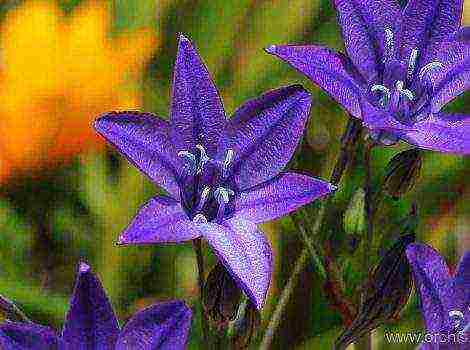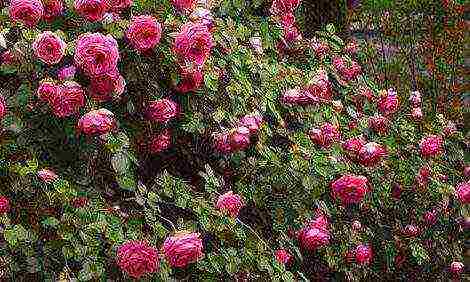Content [show]
 Ideal outdoor radish harvest
Ideal outdoor radish harvest
One of the very first vegetables to be grown outdoors was radish. Its harvest can be harvested several times per season, since radishes are cultivated very quickly.
Radish varieties for planting in open ground
According to the ripening period, early ripening, medium early and late varieties of radish are distinguished. The period from planting to harvesting is for the first 16-20 days, the second - 35-40, the third - 35-53 days, respectively.
The early ripening ones include:
- French breakfast;
- Early red;
- Eighteen days;
- Corundum.
 Early early ripening variety of radish Corundum
Early early ripening variety of radish Corundum
Mid-early varieties:
- Helios;
- Watermelon radish;
- Slavia;
- Sachs;
- Viola.
 Late variety of giant radish Red giant
Late variety of giant radish Red giant
Late varieties:
- Rumpous;
- Red giant;
- Würzburg.
Depending on the variety, root crops can have not only red, but also white (Tashkent white, white virov), yellow (helios), purple (viola). In addition to the traditional round, some varieties have an elongated shape, like a radish (for example, rampous)
When to sow radishes outdoors
Planting radishes in open ground can begin in April, when the soil warms up enough. For different regions of Russia, the timing of sowing radish in spring can be completely different, and depend on climatic conditions.
 Growing radish seedlings
Growing radish seedlings
The optimum soil temperature for sowing radishes is from 15 degrees Celsius. In case of frost, a shelter for young shoots should be used.
Planting dates for radish:
- Early maturing varieties: first decade of April
- Early varieties: late May - early June.
- Mid-season: early July
- Late ripening: late August - early September.
How many times to plant radishes per season
The timing of planting radishes in summer can vary depending on the variety, the timing of its collection and ripening.This vegetable can be harvested four times per season, but radishes cannot be planted twice in the same bed.
- The first sowing is performed in April, taking into account the favorable days of the month according to the lunar calendar;
- Planting radishes in June, at the beginning of the month, is done in a seedling way. For the second sowing, medium-early varieties are used, sown 35 days before transplanting into the ground, that is, May 25-30.
- Planting radishes in July, at the end of the month, is an opportunity for a summer resident to get a root crop for the third time. They also use the seedling method and choose medium early varieties for sowing seedlings at the end of June (25-30 numbers).
- The culture is sown for the fourth time in late August - early September. This is done already in closed greenhouses, and in the northern regions of the country - in heated ones.
Planting radishes in open ground
Sowing radish with seeds is a simple procedure, and usually does not cause difficulties. But first, it is important to choose high-quality seeds and prepare the soil in order to get an excellent harvest.
Presowing preparation of radish seeds
You should buy seeds in specialized stores. First, they are sorted out by size. Usually, seeds with a length of 3 mm or more are selected for planting - this is a guarantee of good germination and development of large root crops.
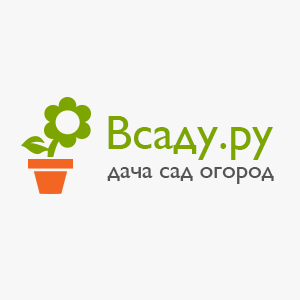 Preparing radish seeds for sowing
Preparing radish seeds for sowing
Before planting, the seeds are kept in a damp cloth or water for 24 hours so that they germinate. Immediately before sowing, they are soaked in hot water for 20 minutes to prevent the development of dry rot.
It is recommended to soak the seeds for 5 minutes in 1% iodine solution, and then dump them in crushed chalk or lime. Such a "masquerade" is needed, since the radish seed is planted one grain at a time, and the white color is clearly visible on the black ground.
Preparing the soil for planting
Growing radishes outdoors requires choosing the right location and soil for planting. Radish takes root well on loose soils, loam is considered the best site for it, which holds water well, and does not dry out instantly.
Sandy soils are also good for radishes, but the crop should be watered more often as the sand absorbs water more quickly. The plant loves the sun, therefore it is better to choose sunny areas for it.
 Composting soil under radishes
Composting soil under radishes
Before planting seeds, fertilizers are applied to the ground. It is optimal if it is compost or ash at the rate of a bucket of fertilizing per square meter of land.
Crop rotation rules for radish
Radishes should not be grown where cruciferous crops grew - cabbage, turnips, daikon, radish, turnips, horseradish. A cruciferous flea can settle in such an area, and with a high probability will destroy all crops.
Early potatoes, legumes, cucumbers, and tomatoes are considered good precursors for radishes. It is ideal if the planting of radishes is protected from all sides by garlic, dill, onions - such plants have a specific aroma that will repel pests.
Sowing radish
For sowing in the allotted area, small grooves are made with a depth of a centimeter, they are moistened and the radish is planted.
 Sowing radish in open ground
Sowing radish in open ground
The seeds are planted one at a time, at a distance of 5-10 cm. If the radishes are sown denser, there will be little room for root crops to grow, and the seedlings will shade each other.
After sowing, the beds are lightly covered with earth, watered abundantly and fertilized with ash.
Growing and caring for radishes
Radish hatch within a few days after planting. After the emergence of seedlings, the culture is fed with potash fertilizers, following the instructions. Caring for radishes is simple: first of all, watering, loosening, thinning and feeding.
- Water the radish 2-3 times a week, 20-25 liters of water per 10 square meters.
 Watering radish beds
Watering radish beds
- If the land is not sufficiently prepared in advance (seedlings wither), when watering it is fed with ammonium nitrate (10-15 grams per 10 square meters).
 Fertilizing for radishes
Fertilizing for radishes
- It is better to mulch radishes with humus, you can use peat, compost, paper, dark film. Mulching helps to retain moisture, which radishes love very much.
 Thinning of radish seedlings
Thinning of radish seedlings
- Thinning is carried out 5 days after germination, removing the smallest ones. Water the culture as needed, carefully loosening the soil after each watering.
Problems with growing radishes
- If the roots became slimy and a rotten smell began to emanate from them, it means that the radish was struck by bacteriosis. Treatment with 1% Bordeaux mixture will help to eliminate this problem.
- With the formation of outgrowths and swelling, yellowing and wilting of foliage, you should start treatment for a fungal disease - keels. Lime milk, which is poured over the soil around the infected plants, will help. One plant will need a liter of such a product.
- Symptoms of the black leg are yellowness and curling of the leaves, darkening of the stem at the root. Affected plants are treated with a solution of copper sulfate and laundry soap.
The main pests of radish and the fight against them
A lot of trouble for radish beds is caused by pests, especially the cruciferous flea, which eats holes in the tops of the radish. If there is a lot of damage, the greens begin to wither, and the root crop itself does not gain the required mass and stops growing. The pest is especially dangerous for delicate radish shoots.
 Radish Damaged by a Cruciferous Flea
Radish Damaged by a Cruciferous Flea
- To protect the plants, they are treated with ash. For ten liters of water, add two glasses of fresh ash and fifty grams of laundry soap.
- The second effective way is to treat the leaves with tobacco dust (in the same proportions as with ash).
 Treatment of radish beds with tobacco dust
Treatment of radish beds with tobacco dust
- The most effective method of control is considered to be insecticide treatment, in particular Inta-Vir.
Belyanka is a dangerous pest of radish. The caterpillars of this butterfly eat the green tops of the crop. To protect the beds, they are treated with a solution of ground pepper, salt and mustard.
When growing radishes in summer, in hot weather, it is necessary to take protective measures against the bear. She does not often eat radishes, but can get into the garden and damage the crop.
The root vegetable of the radish often damages the wireworm (large holes) and the nematode (rotted root base, small holes in the radish with signs of decay).
- To protect against wireworms, the soil is fertilized with ammonium sulfate - two tablespoons of fertilizer per square meter. Such feeding will saturate the soil with nitrogen, and destroy the larvae of the pest.
- Fitoverm is effective against nematode. This powder is safe for humans. It attacks the larvae of rootworm nematodes, which soon die of starvation.
- In the fight against the nematode, soil steaming is also used (watering with hot water from 60 degrees, a liter per square meter consumption), and its disinfection with chitosan-based preparations - Aldikabr, Vidata.
Outcome
Growing radish outdoors is possible throughout the summer cottage season. Even a novice gardener can cope with the simple rules of caring for this crop, if you sow radishes in the beds in time, and provide him with ideal conditions for growth.
Radish is a vegetable with a peculiar pungent taste that gives it the mustard oil it contains. It has good nutritional and healing properties. Differs in high early maturity, cold resistance, unpretentious care, which allows you to get the earliest harvest of fresh vegetables in spring. And if certain conditions are met (temperature, lighting, humidity), you can grow radishes all year round.
1 Features of growing radishes
Radish - planting and caring for this unpretentious plant in the open field does not require a lot of labor. This is a very early ripening vegetable. The early varieties ripen in 18–20 days, the late ones - in 40. This feature and the fact that it tolerates cold well allows it to be planted in open ground as soon as the snow melts, and in the spring to enjoy the long-awaited fresh vegetables.
The second distinguishing feature of it is that this plant is a long day, that is, with a daylight time of more than 13 hours, the root crop abruptly turns into a seed arrow, becomes hollow and inedible. This property forces it to grow only with a short daylight hours - in spring or autumn.
Since radish is a cold-resistant culture, it is planted in the beds before heat-loving vegetables. When the latter comes, the radish is already ripe. They also use it as beacons when planting together in a row with other crops that sprout much later. This allows you to loosen and weed the row spacing before sprouts appear, which, in turn, accelerates germination.

A slightly acidic, sandy loam, nutritious loose soil is suitable for this culture. Root crops will not form in other soil. It must be planted in an open, but not blown by the wind place. In the shade, it goes into the tops and tubers do not develop either. Land for planting is being prepared in the fall.
You can not plant radishes in places where their relatives grew from cabbage, it is best to plant it after onions, garlic or potatoes. In the beds, humus, mature compost, superphosphate, potassium salt are introduced under a deep digging of up to 30 cm. Heavy clay soil can be lightened by adding peat and sand to it. They are sown immediately after the snow melts.
For planting root crops before winter, the beds are also prepared in advance, in warm weather. Furrows are made on them, then covered with foil until the ground freezes up to 5 cm in late autumn or the first snow falls.
2 Technology of planting in open ground
To accelerate the germination of seeds, before planting, they are sifted through a sieve with cells of 2-3 mm (choosing the largest), soaked overnight in warm water and disinfected for half an hour in a bright solution of potassium permanganate. Such preparation will allow you to grow large fruits and protect you from diseases.
In April, radishes are sown in open ground in rows or in a nesting method. When planting by the first method, the row spacing is left 10 cm wide, and in the row between the seeds - 5 cm.When choosing the second option, the distance between the plants is set 5 cm by 5 cm.

Before sowing the planting material, the furrows are watered with hot water, the seeds are covered with earth and tamped. This will improve their contact with the soil and accelerate germination.
To extend the harvesting period of the radish, the seeds are sown not at the same time (which will lead to a one-time harvest of root crops), but after a few days. Overseeding is done until mid-May. You can sow immediately, but varieties of different ripening periods. This makes it possible to obtain fresh vegetables for a longer time, since they cannot be stored, since they quickly, especially early ripening, lose their nutritional and healing properties.
2.1 Landing features in summer
In summer, radishes are usually not planted. Of course, lovers of spicy dishes can grow it during this period, but then it is necessary to artificially reduce daylight hours, otherwise the vegetable will go to the arrow. This can be done by covering the beds with black film or opaque material every day from 18:00 to 08:00.
Suitable for growing in summer varieties and hybrids that have weak shooting, such as:
- French breakfast;
- White Nights;
- Virovsky white;
- Champion;
- Zlata.
In June-July, in order not to make a separate bed for radishes, seeds are sown in the aisle of other crops (young strawberries, lettuce), but less often - at a distance of up to 10 cm from each other.
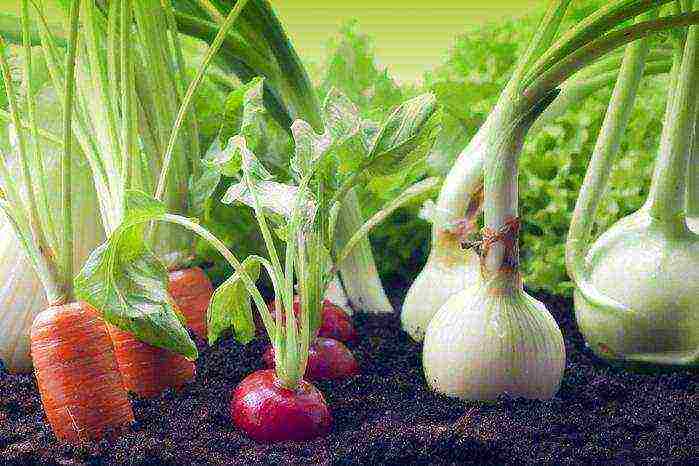
2.2 Sowing autumn varieties
At the end of August or at the beginning of September, they begin to sow already autumn varieties. They are tastier and juicier than spring ones, but due to the great abundance of other garden gifts during this period, they are less popular. At this time, late-ripening hybrids are sown, which must be stored in cool places for up to 2 months, so you can provide yourself with fresh vegetables until the New Year.
Since the sowing of these root crops is carried out on beds freed from other crops, they must be fed with organic matter and mineral fertilizers. The composition of the top dressing per square meter is approximately the following:
- 2-3 kg of humus;
- 1 tbsp. a spoonful of potassium sulfide;
- 1 tbsp. a spoonful of superphosphate;
- 1 teaspoon of urea
- 0.5 cups sifted wood ash.
The beds are dug up and leveled. Since the fruits of late-ripening varieties are large and require more nutrition, their seeds are sown less frequently: up to 20 cm between rows and up to 15 cm between seeds in a row.
When planting radishes before winter, the planting material is laid out in dry furrows, covered with dry soil, and then mulched with compost or peat. If it snows, then the top of the planting is also covered with snow.
2.3 Care of radishes
Caring for root crops consists in watering, weeding, loosening, thinning, feeding (if no fertilizer was applied during the preparation of the garden bed) and pest control.
Watering should be done as the soil dries up, avoiding waterlogging. Moreover, the first watering should be done with warm liquid in the evening, so that the seedlings can better tolerate night frosts. After two weeks, you can water it with plain water.
Since radishes accumulate nitrates, it is best to feed it with an ash solution or infusions of sage and rosemary herbs. They also protect plants from snails, slugs and fungal diseases.
Facilitates the maintenance of mulching the beds with small cut grass, peat or compost, This allows you to loosen less often, get rid of weeds, moisture will retain longer, which means you do not have to water often.
3 Features of growing vegetables in closed areas
To speed up the maturation of radishes, they are often sown in polycarbonate greenhouses. Planting indoors allows you to harvest in March or April. The soil in them, as in the open field, is prepared in the fall. The necessary fertilizing is done with fertilizers, organic matter, the beds are dug up and leveled, and in the spring, as soon as the soil thaws by 5 cm, seeds are sown. Specially bred greenhouse varieties are ideal for planting in a greenhouse:
- Greenhouse.
- Early red.
Good cold resistance allows them to be sown in the middle lane as early as February. If these varieties are not on sale, then you can buy early ripening, which are also suitable for growing in a greenhouse:
- Dawn.
- Heat.
- Sachs.
Growing indoors has its own characteristics. For it to be successful, it creates optimal conditions for humidity and temperature:
- before the start of the mass emergence, the temperature is maintained at + 16–18 ° С;
- then for 4 days hardening takes place at + 6–8 ° С;
- then the optimum for growing + 18–20 ° С is set, night cold snaps and even frosts do not harm the plants.
Greenhouse care is the same as outdoors. Weeding, thinning, loosening and deep watering up to 15 cm, as the surface layer of the soil dries up. For pest control, plants are treated with wood ash or tobacco dust.
3.1 Winter sowing of radishes
Radish lovers can grow it in winter in their apartment on the windowsill, although this is more difficult than in a greenhouse. The problem is that it is more difficult to provide the required temperature and lighting in an apartment, because the rooms are too warm in winter and there is not enough light. Plants go to the tops, and the fruit becomes tasteless.
But if the house has a closed loggia, veranda or balcony, then we will solve the issue. As a rule, in the winter months, during the daytime in such rooms, the temperature is kept from + 8 ° C to + 18 ° C, and at night it is much lower, which is the optimal temperature regime for these vegetables. And in order for the plants not to stretch out due to low light, they must be additionally highlighted. Moreover, the backlight should not increase the lighting time, but the intensity.
LED lamps are used as an illuminator - they do not heat up and consume little electricity. Their work can be automated by connecting through a time relay set for a certain period of time.
Tanks for planting must be at least 15 cm deep. They are filled with soil from a vegetable garden or peat-based soil intended for growing cabbage. Water the plants in the apartment in moderation and only with settled room water.

The following varieties are best suited for sowing under these conditions:
- Early red.
- Greenhouse mushroom.
- Quart.
4 Influence of the Moon on the development of plants
It is impossible not to take into account when planting and other gardening work and the influence of the moon in its various phases on all life on Earth. Observations of it revealed that planting and transferring operations are undesirable during the new moon and full moon. With a full moon, juices accumulate and stagnate in the upper part of the plant, and with a new moon - in the roots and roots. Therefore, when planting these days, the plants do not take root well.
The other two phases of the moon - growing and waning, program the plants, respectively, for the growth of the aerial part or the development of the root system. Therefore, the waxing moon is favorable for sowing vegetables that bear fruit above the ground, and the waning moon is favorable for root crops. This means that the radish must be sown on the waning moon.
It is also very important to find the Moon in the signs of the Zodiac favorable for planting, since they also affect the yield, since they are divided into fertile, average fertility and sterile.
Centuries-old observations have shown that the best harvest is achieved when plants are sown on the days of the phase of the moon they need and when it is in the fertile sign of the zodiac. Therefore, it is so important to carry out all the work in the garden on days favorable for them, referring to the gardener's lunar calendar.
Growing radish does not require a lot of labor. The implementation of simple agrotechnical techniques and the observance of the optimal conditions for its growth can allow gardeners to have this tasty and healthy vegetable on their table continuously throughout the year.
Planting and caring for radishes in the garden beds
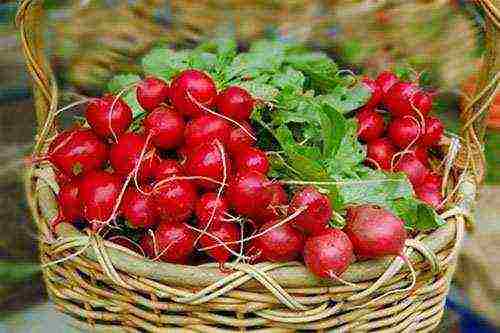
Radish is the earliest root crop, which acquires a marketable appearance in 20-40 days, depending on the varietal timing of product receipt. Planting and caring for radishes is straightforward, even in the absence of experience in gardening. To have a root vegetable on the table all summer, you should use some special techniques.
Radish agrotechnology

When growing radish, you need to know the following features:
- cold-resistant culture with possible podzimny sowing;
- the soil for the culture should be fertile, but without fresh organic matter;
- long daylight hours create conditions for shooting, to the detriment of filling;
For planting and caring for radishes in the open field, choose an illuminated area. Before sowing, the soil is filled with rotted manure, complex mineral fertilizers and well dug up. It is better to prepare the garden in the fall, and sow in the winter or early spring. It should be borne in mind that the seeds are placed in the grooves to a depth of 1 cm and the ground above them is compacted.
For continuous plantings, it is better to use a marker with 5x5 cm teeth. Then the seeds are placed at the same distance with an even depth and compaction. Seedlings appear at the same time, thinning is not required. Each gardener chooses how to plant a radish. You can sow a separate bed, make markers from seedlings for tightly similar crops, or poke along the edges of beds with other crops.
By sowing seeds with different ripening periods, you can get products from one garden bed within a month. So, the French breakfast radish will delight you with tender crispy pulp 20 days after germination, and the Ice Icicle will have marketable ripeness in 45 days. Thus, it is possible to have fresh radishes on the table within a month from one sowing date.
How to harvest early radishes
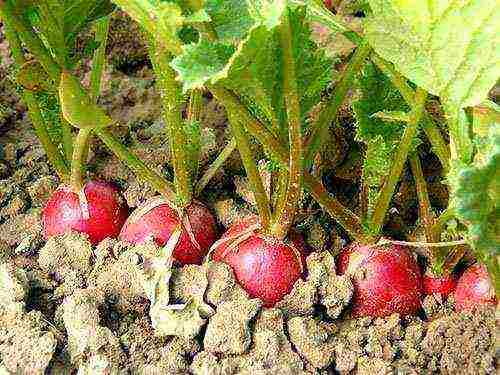
In order to have your favorite root crop in May, you need to take care of this in advance. An open place is selected on the site for early planting.Later, it will be possible to plant thermophilic crops here. There are several ways to grow your first crop radish outdoors. For sowing, you need to choose fresh large seeds of early ripening varieties. The seeding rate is 2-3 g / m 2. Sowing of seeds, depending on the region, is carried out at different times - in winter or early spring under a temporary shelter.
Podzimny sowing is carried out with a steady onset of cold weather in pre-prepared furrows. From above, the sowing is covered with thawed soil prepared in advance. In spring, the seeds will hatch early, as shoots appear at 2-3 degrees and withstand return frosts up to 6 degrees. Another way is winter sowing. In the middle of winter, snow is removed from the garden, seeds are laid out along the furrows and covered with peat with a layer of 2 cm.

Sowing radishes before winter and in winter allows you to get the first harvest a decade earlier than with the spring planting method. The area with early seedlings is covered when the temperature drops, but more often a temporary shelter made of arches is installed over such a bed.
If the early radish is grown as a business, the best way is to sow the seeds using a marker and 40-50 cm spacing between strips with continuous sowing. This crop placement will provide plant maintenance. The entire area is covered with a foil frame with ventilation. Early sowing on prepared soil is done when the ground has thawed by 2-3 cm.If the morning frost on the soil was stronger than three degrees, the plants are watered and shaded before the sun's rays touch the plant. Radishes grow quickly if they have enough moisture and sunlight. Root crops are sampled gradually, as they ripen.

Sowing radishes during the summer
Sowing of early varieties is more often used at several times, every summer month. How to grow radishes at the height of summer, when daylight hours are longer than 12 hours? Radish should go into the arrow at the height of summer precisely because of the illumination regime. Therefore, in the summer, they artificially shorten the day, covering the garden with radishes with dark geotextiles in arcs. It is impossible to cover with a film, as the sun will create unbearable heat under the shelter. It is necessary to light the garden bed for 10-12 hours, only then you can get root crops, and not an arrow with seeds.
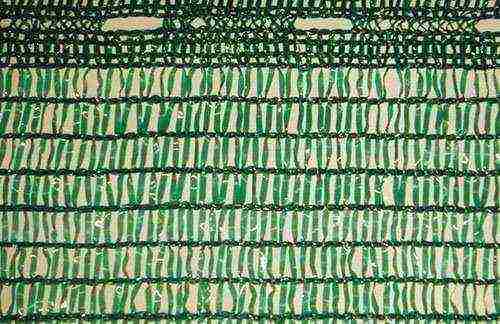
Summer heat interferes with flooding, dries up the ground, contributes to the appearance of pests that eat up leaves, gnaw at roots.
In summer, the bed should be damp, loose and constantly sprinkled with wood ash or tobacco dust. No insecticides can be used on early-maturing crops.
When to plant a radish a second time depends on the willingness of the owners to maintain a light regime for it every day. If it is possible to provide watering and daylight hours, at the height of summer, the root crop can be grown using non-shooting varieties. But on hot days, the filling is weak. In the shade, the radish will release a lot of green at the expense of the head size. Sowing radish seeds in June is irrational.
Planting radish in July is more in line with its biology. In the second half of the month, the heat subsides, the sunny day is shorter and the night is colder. Therefore, in August, they get a new wave of delicious root vegetable. Planting and caring for radishes in the open field ends at the end of September, when large roots of late varieties are harvested for winter storage.

To get radishes in September, planting radishes should be done in early August. The beds that have been freed from onions for turnips are the best fit. They are well fertilized, loose and there is enough time before the onset of cold weather to obtain a marketable radish. Planting radishes in August and early September is practiced in areas with a warm climate. There, the favorable development of root crops is ensured even at the beginning of October. Trans-Urals should finish growing in the first half of September. These climatic conditions are used to plan the timing of sowing radish seeds for storage.
Greenhouse growing of radishes
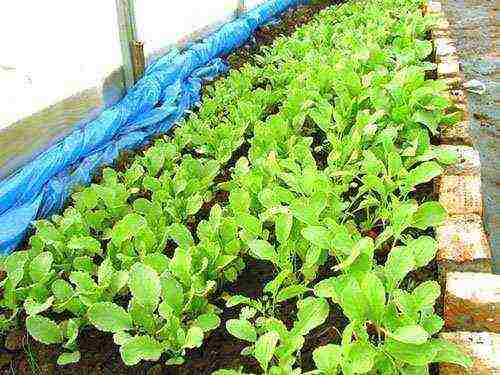
The Siberian climate does not allow for the first crops before May. Therefore, the greenhouse method of growing radishes in spring is widespread in this area. Radishes are the precursor to tomatoes and peppers in stationary greenhouses. Sowing it is done in April in order to get the first roots by mid-May.
When cultivating radishes in a greenhouse, it is important:
- choose exactly greenhouse varieties that are not prone to shooting;
- provide the plants with illumination;
- thin out radish seedlings in time;
- airing, watering, loosening are required.
If you do not follow the conditions for planting and caring for the radish, a lot of greenery will grow to the detriment of the root crop, but the leaves of the greenhouse radish are tender and suitable for making salads.
In Japan, radish leaves are considered the most valuable vitamin greens and they are eaten.
Obtaining radish seeds

Radish is an annual crop, so you can get the seeds yourself. For this, testes are grown through seedlings. Testes grown in containers are rarely transplanted into open ground, after 30 cm and row spacing of 70. Plants are fed with phosphorus-potassium fertilizers and are protected from insect pests.
The pods obtained on the bush turn yellow in September. Such stems are cut, ripened and dried for two weeks and threshed. In Siberia, the seed plant is grown in a container, in September, it is brought into a greenhouse and grown indoors. The threshed seeds are calibrated, leaving only large ones.
Video about a little trick when planting radishes
Gardener tips: how to grow radishes outdoors
Radish is a fairly early ripening vegetable. It is often grown in greenhouses. But you can do this action in the open field. To do this, you need to know just a few simple rules and even an inexperienced gardener can handle the process.
Features of soil preparation
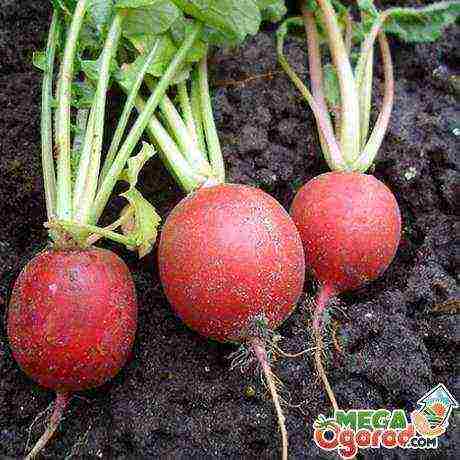
In order for the radish to fully grow and develop, it needs to prepare a favorable soil. When planting radishes, you must remember that its soil should be as loose as possible. If such soil is not provided for this plant, then cracks will form on its fruits. That is why, before planting radishes, the soil is dug up and the appropriate fertilizers are introduced into it.
The ideal option for planting this plant is super-sandy, slightly acidic soil.
Fertilizing the soil:
- In order for radish to form root crops correctly, it must be provided with an optimal amount of mineral fertilizers. These fertilizers include potassium salt and superphosphate.
- Fertilization of the soil directly depends on the planting period of this plant. When applying fertilizers, you need to know that fresh manure adversely affects radishes. That is why it is by no means worth using it as fertilizer.
- Fertilization of the soil should be done in advance. For example, if radish planting is planned for the spring, then the soil is fertilized in the fall.
- Per square meter of the area allocated for radish, it is necessary to bring at least one bucket of manure, which is overfilled.
The choice of a place for planting this plant also plays an important role. This culture is very fond of lighting and therefore must be planted in very well-lit areas. Also, the planting site of this plant must be reliably protected from the wind.
Planting methods for radish

There are three ways to grow radishes outdoors:
- Spring
- Winter
- Let's winter
The podzimny method of planting this plant consists in sowing seeds in the month of November. In the event that at this moment the ground is frozen, then dry seeds must be sown into the ground. After sowing radish seeds, they are covered with humus. This method of planting this plant requires the choice of a southern or southeastern site. Also, when planting radishes in the winter period, it is necessary to pay attention so that in the autumn period the place is not flooded with submerged waters.
In order to get radish shoots not two weeks earlier than during spring planting, it is planted in winter.
When using this method of planting, the beds are prepared in the fall. For this, grooves are cut, the width of which is five centimeters. During a snowy winter, snow is removed from the beds before planting radishes. Seeds are sown into the prepared grooves, and they are covered with peat on top.
The spring method is most often used when planting this plant:
- Planting radishes after the retreat of the winter cold.
- Radish is planted directly into open ground.
- The planting time of radishes in the spring directly depends on the characteristics of the region.
- Most often, radishes are planted from late April to early May.
- Planting radishes is carried out only when a long-term temperature is established at +15 degrees. In this case, the night temperature should be at least +5 degrees.
- Before planting the seeds, the beds are dug up and grooves are made in them.
- The distance between the grooves should be at least twenty centimeters.
- Planting seeds can be done in whole handfuls. Crops are dug in and moistened abundantly.
If the need arises for the emergence of seedlings a few days earlier, the place of planting of this plant is covered with a film. The first shoots of radish appear within five days. Most often, a large number of seeds are used for planting radishes, so the first shoots appear crowded.
In order for the radish not to "stack", it must be weeded out. For this, the strongest plants are selected. 2-3 seedlings are left after 5-6 centimeters. After a few days, the strongest are selected from these seedlings, and the rest are pulled out.
Features of radish care

In order for the fruits of the radish to be large and juicy, it needs to be weeded regularly. This not only removes weeds, but also loosens the soil, which has a beneficial effect on the size of the fruit. Also, this plant needs watering. In very dry soils, the fruits of the radish will taste small and bitter, and its ground part will begin to throw out arrows. Thinning of a given plant should only begin when the seeds are mostly germinated. This action is performed approximately 5-7 days after sowing when the rows are clearly visible.
After the final thinning, the radishes must be watered with a watering can for rooting.
This is necessary, since during thinning, the root system of the radish can be disturbed, which may not strengthen without water. Watering the radish is necessary from a watering can. On average, two liters of water must be poured over one square meter of the garden bed.
Also, after planting radishes, he needs to ensure timely fertilization. Urea and mullein are used as fertilizers. You need to take one teaspoon of urea, and one glass of mullein. With five liters of the resulting solution, 1 square meter of the garden can be treated. Thanks to the introduction of these fertilizers, the development of radish will be significantly accelerated. In order to limit the radish from the possibility of a pest attacking it, before weeding the beds, it is necessary to pour ground pepper or dry mustard in an amount of 1 teaspoon per 1 square meter.
Harvesting is done as it ripens. If the fruits have reached normal size, then they must be harvested. To do this, you just need to gently pull the plant by the stem.
Pests and diseases of radish
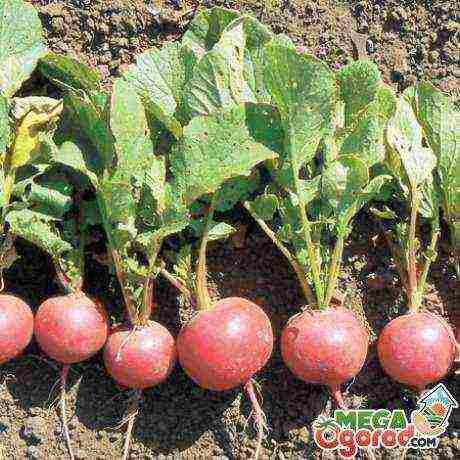
Radishes can be affected by weevils, cabbage moths, cabbage fly larvae and many others.
In order to limit the possibility of the appearance of these pests, it is necessary to sprinkle the beds with ordinary wood ash. Before planting this plant, you should not use wood ash, as it can cause arrows to appear, which will negatively affect the harvest. If radish is damaged by pests, it is necessary to immediately begin to combat them.
Radish pests and diseases:
- If you find a weevil beetle in the garden, then you need to spray the plant with special insecticides. Also, to prevent the appearance of this pest, you can plant garlic and onions around the garden garden. Cabbage moth attacks the ground part of this plant, which negatively affects the yield. When this pest appears, the garden with radishes must be treated with antibacterial drugs.
- Cabbage fly larvae are a very dangerous enemy of radishes. Therefore, when they appear, you must immediately begin to fight them. When this pest appears, the plant bed is treated with special insecticides or wood ash.
- Radish can also be affected by diseases such as powdery mildew, black leg, white and gray mold, etc. Powdery mildew appears on radish leaves as a white bloom. When the first signs of the disease appear, you must immediately begin to fight it. For this purpose, both chemical and bacterial methods can be used. With the bacterial control method, special spray preparations are used. When using a chemical method, the use of fungicides is required. Also, when this disease appears, it is imperative to remove the affected leaves of the plant.
- When a black leg appears on a radish, it is necessary to start fighting it immediately, otherwise it will destroy not only the ground part, but also the fruits of the radish. To do this, it is necessary not to overmoisten the soil during irrigation, and also to carry out regular loosening. You can also use insecticides to combat disease. White and gray rot can occur on the tops and tops of radishes above the ground. At the first signs of this disease, it is necessary to remove the affected plants from the garden, and also treat them with special preparations.
Growing radishes in the open field is a fairly simple process, which consists in sowing, caring for and controlling pests and diseases.
More information can be found in the video.
How to plant radish seeds correctly
It is impossible to feel that at last, after a long winter, spring has come, and the long-awaited summer is approaching more and more inexorably, until a radish appears on the table. Delicious and very healthy, on the table in a salad bowl or even just in bulk on a platter, she seems to say with her whole appearance - I have come, and wait for the summer. But what is the right way to plant a radish?

A little about radish
Crispy, slightly sharp and bright radish tubers are a real storehouse of many mineral salts - magnesium, potassium, calcium, iron, phosphorus, vitamins - C, B5, B2, B1, enzymes and organic acids. And isn't that why a person has such a positive attitude to the first spring radish that appears on the table at a time when the body needs all of them very much? This article will guide you on how to plant radish seeds.
There are two types of this plant - annual and biennial. The first consists of European varieties and produces seeds with root crops within one year, while the second consists of Asian winter varieties that produce seeds only in the second year. This article discusses the rules on how to plant European radish seeds.
Radish is an early ripening, cold-resistant, light and moisture-loving plant belonging to the cruciferous or cabbage class. Depending on the region of cultivation, it can bear fruit from 2 to 5 times a year. To get a good and consistent harvest, you need to know how and when to plant your radishes.

Preparing the soil before planting radishes
Many people really want to know how to properly plant radishes in the spring. It all starts in the fall, when the beds are prepared (raised by 15 cm) and the necessary organic fertilizers are applied - but carefully, without excessive fanaticism - because from an overabundance, for example, of humus, large "tops" and frail "roots" can grow.
Then, in the spring, after the main snow melts, mineral fertilizers can be sprinkled on the beds under the radish. The snow remaining on them, during thawing, will enrich the soil with the necessary macro- and microelements. But not potash - an excess of potassium will make the roots weak and lead the radish into the arrow.
The beds are made in a sunny and warm place, and for the fastest heating of the soil, it is advisable to cover the beds with black polyethylene for 9-10 days. Before planting the seeds, it remains to remove the film and dig up the beds with a shovel's bayonet depth. That's it - you can plant radish seeds.
Some features of plant compatibility
When planting radish seeds, it is important to remember that all garden plants obey a certain law of compatibility, breaking which you can be left without a crop. What is the correct way to plant a radish with all this in mind?
In this regard, a culture such as radish should be planted next to head lettuce, which will prevent earthen fleas from damaging the plant. And if you surround the radish with beans, then its tubers grow larger and have a more delicate taste. In general, radishes are friends with potatoes and spinach, as well as onions, garlic, beets and cabbage. But it is not recommended to plant radishes with cucumbers.
Radish outdoors under a film
How to plant radishes under a film? When planting seeds in the ground, the "rule of three matches" must be observed. The seeds are planted at a depth corresponding to the length of the match, the bed from the bed is at a distance of the match, and the seed from the seed is planted in a row for the length of the match.

The soil for radish is desirable loose, and after planting radish it is recommended to mulch it - sprinkle it on top with river sand, sawdust or peat. Considering that there is still snow when planting radishes, you can throw more of it on the rows with planted seeds, but not too much. The next step is to install a spandbod material over the shelter beds.
The first shoots appear when the last snow melts. At this point, it is important to pay attention to the density of seedlings and, if necessary, thin out the rows or add seeds. When spring is warm, be sure to do airing by raising the spandbody for a while. The first radishes on the table can be harvested in three weeks, if a good spring permits.
Radish in greenhouses
How to plant radishes in a greenhouse? Getting earlier from

giving birth to radish is possible when planting it in a greenhouse. The soil in greenhouses is prepared somewhat differently, because radish is not the leading crop in them. He, so to speak, sits down on what is already planned to be planted in the greenhouse. Therefore, seeds are planted not in the greenhouse beds, but between them, and a week or two earlier than the main crop.
How to plant radish seeds in greenhouses can be read on many sites. Basically, the seeds are planted to a depth of half a centimeter and covered with earth. Seeds should not be thickened, and when strongly elongated seedlings appear, it is advisable to sprinkle them with earth, otherwise you can be left without root crops. Mineral fertilizers should be applied twice - at the very beginning, after planting the seeds, and after a week.
Radish in greenhouses
In greenhouses, radishes are also planted according to slightly different rules. Since here he is the leading crop - all others are planted after him - the land is prepared a little differently, and the timing of planting is determined by the weather and the design of the greenhouses. Since radish loves both warmth and sunlight, suitable conditions in greenhouses can be achieved somewhere after the first ten days of April.

The greenhouse soil must be carefully leveled. If it is too dry, it should be watered just before sowing, and when the ground is excessively wet, dig up the ground to the depth of a bayonet and ventilate the greenhouse by opening a little frame.
What is the best way to plant radishes? To accelerate the emergence of seedlings, seeds intended for sowing in a greenhouse, it is advisable to germinate.They are soaked for two hours, and then poured into an even layer on cheesecloth in plates, covered with calico and kept warm. As soon as the sprouts begin to hatch - it's time to plant them in the ground. The optimum temperature in the greenhouse when sowing radishes is from 15 to 20 degrees.
Radish on the windowsill
If you really want radishes, but there is no summer cottage or vegetable garden, then those who wish can try to grow this plant on their windowsill. Moreover, this can be done without waiting for spring - albeit in December. It is enough to have a potting mix, a box where radishes are planted, and the knowledge of how to plant radish seeds when growing it at home. Excellent light and cool location is required. It may well be a window sill. It is worth noting that despite the fact that the radish is a short-day plant, the winter day is still too short, so additional lighting will not hurt the radish.

Radish seeds are planted in boxes to a depth of 1 centimeter, at a distance of 5-7 centimeters from each other and must be rolled. The main feature of growing radishes on the windowsill is the temperature regime, which must be observed.
After the first shoots have appeared at room temperature, you need to cool the plant by keeping it at a temperature of about 7⁰C for about 4 days, and then set it to 17⁰C in good sunny weather and 15⁰C in cloudy weather. Maintain the temperature at about 13⁰C at night. This can be achieved by regulating the flow of cold air with the help of a window.
Of the fertilizers, cow manure is used in an aqueous solution with the addition of 10 g of potassium salt and 15 g of superphosphate per 10 liters of water. The growth of radish root crops occurs within one and a half to three months, so the harvest is removed selectively.
Features of care and pest control
Watering for radishes is a necessary thing, so it should be carried out two to three times a day. But if the radish in the open field receives a lot of moisture - in a rainy spring, it can overripe - glassy, crack and rot.
The main pest for radish is the cruciferous flea, which is fought with "pure" solutions that do not have chemistry. This is done because the radish ripens quickly, and the roots do not have time to get rid of it.
It can be infused tobacco dust or ash. Such a remedy not only has a protective effect, but is also an additional fertilizing for radish.
Radish is a good root vegetable
If we hear "radish", then we immediately remember "Gentlemen of Fortune". But in this article, we will not talk about a "bad person", but about a tasty and healthy plant that every third gardener has in his country. In early spring, it is one of the first sources of vitamins, and radish has antimicrobial properties.
Radish belongs to the cruciferous family (like cabbage). The most common are its annual (European) varieties, which give root crops and seeds in the first year of planting. But there is also a two-year-old radish (Chinese varieties), in which the root crop appears in the first year after planting, and seeds in the second year. We will consider only the first, one-year option, as the most popular in our area.
The roots of such radishes can be round, flat-round or cylindrical. The color can be rich red, pink, white, purple and even yellow.

I confess that I am a lover of round heads and varieties with a minimum amount of bitterness. For the most part, I use radishes for salads and for eating fresh, sometimes I add slightly pubescent leaves to salad.
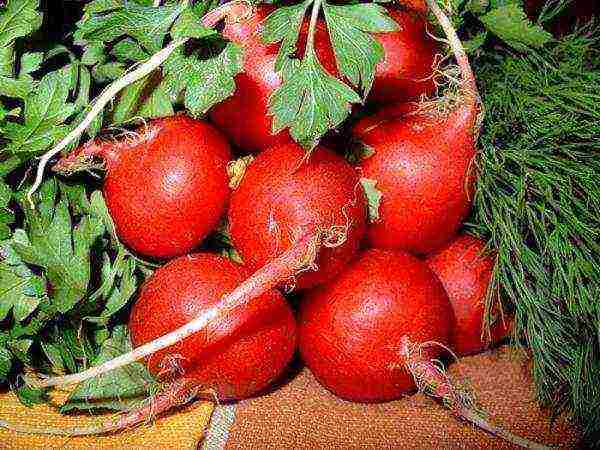
Planting radishes
I sow radish seeds directly into the soil, I can do this all summer to get a young and tasty harvest. In early spring, radish is one of the first vegetables to come to our table.
Give your radishes a sunny, wind-free location with light soils. My radish grows in a sunny place, but on one side it seems to be covered by the garden.Therefore, a little more than half of the day there is the sun on the radish site, and this has a good effect on it, the roots are juicy, with tender pulp. On the site where I grow radishes, I have slightly acidic soil, I have never had any problems with growth. And radish will definitely grow well on neutral soils. This culture loves light, loose soils (sandy loam).
Radishes are responsive to organic fertilizers in the soil. I plant the radishes in a different place every year so that the predecessors of the radish are vegetables from a different family. It is not recommended to sow radishes after cabbage, horseradish, watercress and other cruciferous plants, as microorganisms accumulate in the soil that can cause diseases inherent in this family.
Preparing the soil for radishes
For autumn digging, add humus or compost. Usually I dig to a depth of about 30 cm. When spring comes and I dig the soil again to form small beds to a depth of about 20 cm, I definitely apply phosphorus-potassium fertilizers.
Sowing radishes
I always grow radishes in the open field in a seedless way, and even several times over the summer. I do the first sowing at the end of March, when the ground is still frozen. I plant the next batch at the end of April or in the first week of May. But I can plant it on the 20th of May. If I decide that I also want radish in the fall, then I sow it at the end of July.
Radish can germinate already at 5 ° C, but this will take an extremely long time. If the temperature rises to 15 ° C, then the seedlings will appear in a week, and at 23 ° C, the seedlings can please already on the 4th day. The optimum temperature for growth is 20 ° C.
Under the radishes, I make grooves with a distance of about 20 cm from each other. At first, I sow radish thickly, but after germination I break it out so that the roots do not interfere with each other, at a distance of about 5 cm. I water the grooves when the ground is very dry and cover the seeds to a depth of about 3 cm.If the soil is wet, I do not water it when planting.
Radish care
I water the planted radish every day in a dry summer. If the weather is not very hot, I can reduce the amount of watering to 1 time in 2 days. Moisture is very important for radishes, but if it comes in unevenly, then the roots can crack. With an excess of moisture, radish becomes tasteless and has a watery pulp tissue structure. If there is not enough water, then bitterness, elongation, and hardness of the crust cannot be avoided.
On poor soils for early varieties, one mineral dressing can be carried out, for later varieties, two dressings can be carried out, but no more. My first experience with feeding radishes was unsuccessful, because I fed my radishes with large doses of nitrogen fertilizers, this caused huge foliage growth and pulling of root crops. At the same time, they were born very small and collected a lot of nitrates. Don't repeat my mistakes.
Radish varieties
Radish, like many vegetables, is divided into varieties that ripen early, medium and late.
Radish "Zarya"
This early variety is good for both open and protected ground. It will take 20-30 days from grown seedlings to harvest.
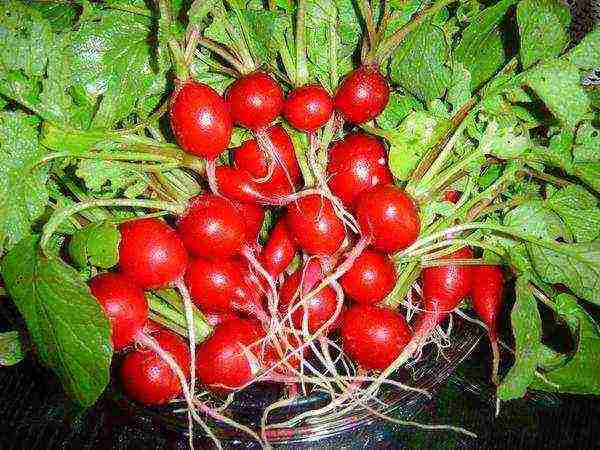
Early red radish
It will also take about 30 days from full germination to full maturity. The color of the root crop is dark red, the cultivar is attractive for its resistance to shooting. The pulp is tender, dense, white, very juicy. Good for soil and greenhouse conditions.
Radish "French breakfast"
The cylindrical shape of the fruit of this variety is loved by many gardeners. The color of the fruit is bright scarlet with a white tip. The pulp is tender, juicy, without a drop of pungency. This variety ripens in about 23 days. The mass of the fruits themselves is about 20 g.
Radish "Helios"
It will take 30 days from germination to harvesting with this variety. The variety is yellow in color, rounded root vegetable has a delicate taste and tender pulp. According to the ripening period, it can be classified as medium early.

Viola radish
Medium early, violet, round, juicy fruits.

Watermelon radish
Suddenly, inside the greenish-white fruits, bright crimson pulp is found, it looks very unusual and beautiful. The radishes are large, 7-8 cm in diameter, the flesh is dense, not very juicy and crispy, sweeter inside than outside. The intensity of the flavor decreases as it matures.

Svetlana, Russia
Eh, Vera! Inspired by the longing for spring! I always plant red or pink varieties with a white tip - always round. The fruits of this radish cause me a downright aesthetic pleasure))) But you know, it's somehow strange, I only want to eat radishes in the spring, although I really like its taste! Somehow quickly we gorge on them, so I never sow much. And the post is super, as always, salivating from the photo))) ++!
Vera, Eagle
Light, can you imagine, I also love it until the second half of the summer and in winter something sticks to December, okroshka or prison will blow and the radish is in the air)))))
Svetlana, Russia
Who would doubt that our tastes will not converge this time!))) Yes, and for the New Year we often buy a bag or two of radishes in Magnet. Only I don't really want to buy there, I'm afraid of all sorts of pesticides to eat up (((
Marina, Nekrasovskoe
So it’s the same for me: in the spring I want radish right up to the shivers - I don’t wait until it ripens, but if you knock the hunter down, it’s no longer necessary, it’s like. Well, maybe okroshka. But once I replaced the sowing of radish with a radish (variety Ladushka) - it looks and tastes like a radish, but it doesn't shoot so fast. And we ate this radish with pleasure all season in salads. And from the varieties of radish I like Sachs - his tops are short, and the roots are round, large and strong. This year she sowed a multi-colored mixture (I wanted beauty :)) - only yellow radish came up and grew ((And there was also (if you believe the photos on the package) and white, and raspberry, and lilac ...)
Lyudmila Uleiskaya, Yalta
Interestingly, the radish came to Europe thanks to Marco Polo. As a vegetable delicacy, it quickly spread, especially in France, where it remains a national food today. That is why it is still often called French radish. Radish was brought to Russia by decree of Peter I, who became interested in this root crop while staying in Holland. By order of the tsar, they began to grow radishes in the gardens, planted near the Summer Garden. He was included in the menu of the royal family every day. After the death of Peter I, the cultivation of radish almost stopped and recovered a century later.
Alla Lankova, Milkovo
As a child, I was very fond of the radish that my grandmother squeezed: long, the size of a large carrot. We peeled it, grated it and seasoned it with sour cream. I don't know the variety. Now, no matter how much I tried, I cannot find the seeds of such a radish. Does anyone know what this grade is?
Marina, Nekrasovskoe
Alla, this description reminds me of the "Ladushka" radish. This is a summer radish, in which the root crops are similar in shape to a carrot, and in color and taste - to a radish. At one time I grew it instead of radish, which in summer, in the heat, does not work well. "Ladushka" is devoid of this drawback, so it can be grown all season without interruption. And then in our stores her seeds disappeared somewhere, and I gradually forgot about her. Thank you for reminding me! We must search in order to sow in the summer
Lyudmila Orlova (Abramova), Yekaterinburg
Alla, maybe it was not a radish, but a daikon? The size is about the size of a large carrot, the taste is like a radish, even a little softer, if not overgrown.
Alla Lankova, Milkovo
I think it's still a radish. Or maybe a radish. The skin color is red. Is Daikon red?
Alla Lankova, Milkovo
Thank you Marina for your answer. I found a description of this radish on the Internet - it is similar. I think that this year I will already sow and remember the taste of childhood)))
Tatiana, Sudislavl
For two years in a row I have been sowing the Red Giant radish, it is bright red, the flesh is white, juicy, with a pure radish taste. Sowed 2 times per season, the latter turned out to be not very red and more pungent in taste, watered intermittently. But they were kept in the basement until the New Year.The largest was 18 cm long. I saw seeds in stores this year.
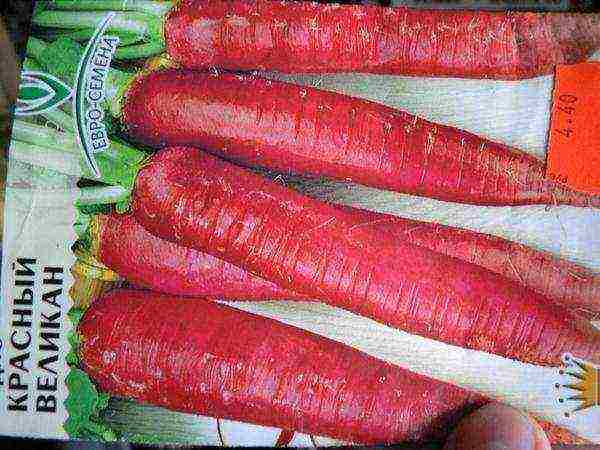
Alla Lankova, Milkovo
Thank you Tatiana. The failure of my search for radish seeds was probably the fact that I bought seeds mainly from the Sedek online store. Now I know that the seeds of such a radish are on sale, so I will definitely find it.
Ramazan Alimgulov
I really love radishes and have been growing them all summer. It is not only tasty, but also very useful. Eat radishes and be healthy! wp.me/s4vrNX-rediska
Elena Efremova
And I sow radishes only in the spring, not because only then I want to. I tried to sow both in summer and in autumn. useless! In the summer, it immediately shoots, in the fall, if the arrows again early, if later it does not have time to ripen. Maybe you need to use some other varieties, or maybe because of our too hot and dry summer (Stavropol region, KMV region). We must try to find a radish “Ladushka”. All the same, in the fall, you want to eat okroshka and nibble on it, but it's scary to buy in stores and even in the market.
Growing radish outdoors
Rate this post
Radish is the earliest vegetable and is grown everywhere from spring to autumn. It is he who, due to its cold resistance and early maturity, first appears after the long winter months in our diet. The vegetable has a characteristic pungent taste due to the presence of mustard oils in the composition. It also contains a whole range of vitamins and minerals.
How radishes grow
This culture is most often cultivated in the open field. Radish perfectly tolerates low positive temperatures, although indicators of about + 15 ... + 18 ° C are considered optimal for its growth... In care, it is undemanding, and therefore any novice gardener can successfully cope with its cultivation.
Due to its short growing season, this vegetable can be harvested several times per season, from very early spring to late autumn. Early varieties reach nutritional maturity within 3-4 weeks after planting. Many gardeners practice sowing radishes at intervals of 7-10 days for a continuous harvest.
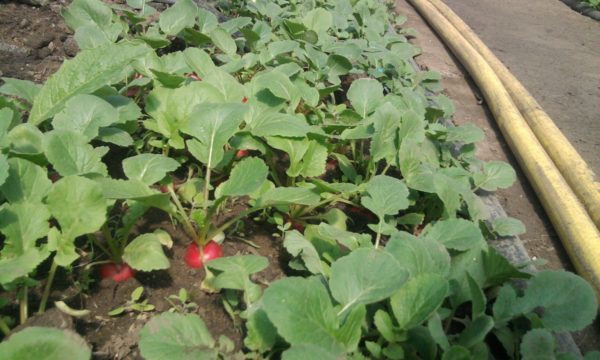
Radishes are most often grown outdoors.
Planting radishes in open ground
Early spring sowing is carried out after the snow melts and the soil warms up. When the air temperature is above + 1 ... + 2 ° C, the seeds are already capable of germinating. However, the following should be considered:
- at values less than + 10 ° C, the seed germinates for a long time, sometimes up to 2-3 weeks;
- at temperatures from +10 to + 15 ° C, seeds are capable of germinating in 7–8 days;
- if the average temperature fluctuates between +18 and + 23 ° C, then seedlings will appear already on the 4th day.
Usually sowing occurs in mid-April, although in the southern regions, radishes can be sown as early as mid or late March.
Soil preparation
The garden bed is set up in a well-lit, wind-protected area. You should not grow radishes in the place where representatives of the Cruciferous family, to which she herself belongs, previously grew: turnip, radish, cabbage, mustard, daikon. For best yields, it is recommended to alternate the planting site with plants from other families.
Radish is an excellent precursor for other vegetable crops such as tomatoes. He will prepare the soil and have time to give a crop before planting tomato seedlings.
Plot for radishes should be prepared in the fall. Soft and loose soil with weak or neutral acidity is best suited for its planting. Heavy and poor soils will need to be fertilized with humus (2-3 kg per 1 m²). Clay soil can be dug up with the introduction of coarse sand and peat. The addition of various mineral complex fertilizers (superphosphate, potassium salt, etc.) will have a very good effect. They are added at the rate of 1 tbsp. l. for 1 m². If the soil has high acidity, then it must be deoxidized using lime (fluff) or wood ash.
Before planting, the plot for radish needs to be dug up and leveled with a rake.
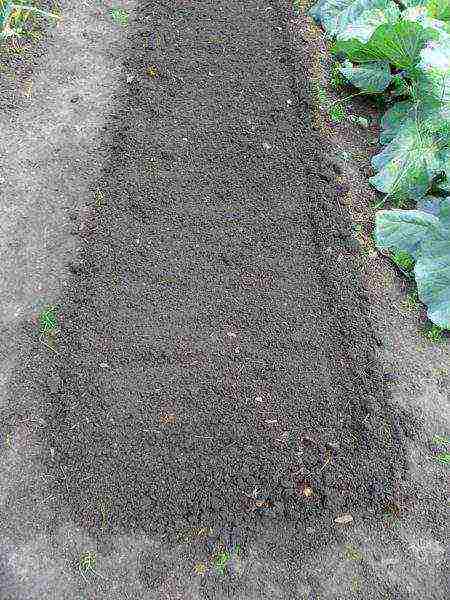
Radish loves soft soil, so the garden should be dug up and carefully leveled
Seed preparation
The seed must first be sorted out (calibrated) manually or through a sieve, taking samples of at least 2-3 mm in diameter. This will ensure better germination and a bountiful harvest.
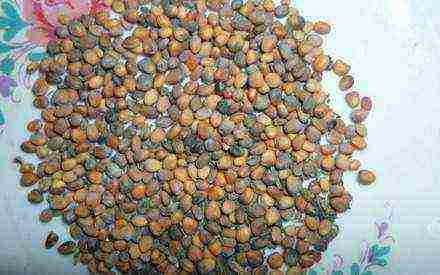
For sowing, you need to select large seeds
Selected seeds should be soaked to "wake up".
- Wrap the seeds in a wet cloth and put on a saucer.
- Put in a warm place, best of all - on the radiator, so that there is constant heating. The temperature should be around 30 ° C.
- Moisten the fabric as it dries.
- Unwrap the seeds once a day and rinse them with warm water.
Awakened seeds sprout much earlier.
Sowing
After selecting and awakening seeds, you can sow them in the ground. The planting procedure takes place in a few simple steps.
- Furrows are made on the bed, about 2–3 cm deep and 15–20 cm apart.
- The grooves are well spilled with water.
- Then planting material is laid out in them with intervals between seeds of 2-3 cm.
- The grooves are covered with earth and slightly compacted.
- Mulch with a layer of peat or humus (about 2 cm).
- The bed is covered with a film or any covering material until shoots appear. After it is removed.

Seeds are planted at a shallow depth
When planting seeds, the structure of the soil must be taken into account. In heavier clay soils, they need to be planted at a shallower depth.
Video: sowing radish in open ground
Outdoor care for radishes
The time of emergence of seedlings directly depends on weather conditions. If they are favorable, then the first leaves may appear as early as 4–5 days. Further care of the seedlings consists in regular watering, loosening and thinning the plantings.

Under favorable conditions, radishes germinate in 4-5 days
Watering the radish
The key to a good radish harvest is proper watering. This crop prefers soil moisture of at least 75–80%. Lack of moisture affects the taste of root vegetables - they become too bitter. In addition, in conditions of excessive dryness, the plant grows green mass and shoots without forming root crops. Excessive moisture, especially before ripening, threatens with cracking or rotting of the fruits, and also spoils their structure - they become watery.

Radishes are very fond of good watering
Radishes require daily watering in the evening or morning hours. In dry periods, it is necessary to moisten the planting twice a day. You should especially carefully monitor the soil moisture immediately after the appearance of the first pair of leaves. The ground should be constantly slightly damp and in no case dry out.
Thinning of seedlings
After the appearance of the first two leaves, the seedlings must be thinned out, otherwise the fruits will not be able to fully form. The distance between the plants should be at least 3-5 cm. If a large-fruited variety is grown, then about 8-10 cm should be left. The smallest and weakest shoots should be removed, leaving the strongest ones.
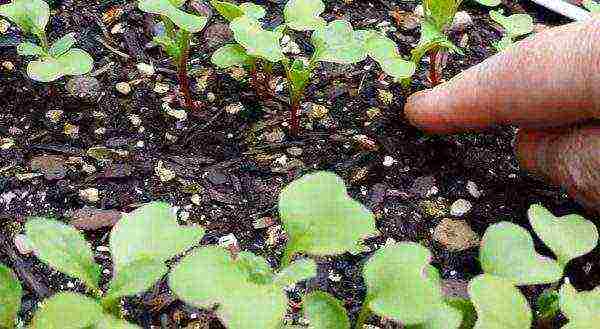
It is necessary to thin the radish to obtain larger root crops
